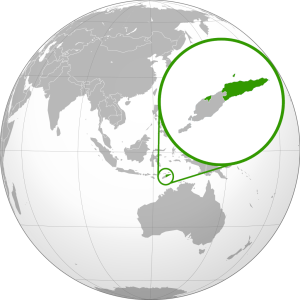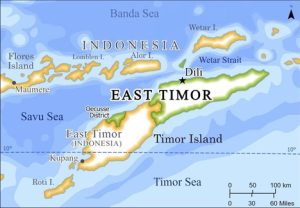48 SE Asia: Historical Geography II – East Timor
 While the whole island Timor had native population, in 1520 it was claimed by the Portuguese. However, in 1640 the western side of this small island was taken over as a Dutch colony. Portugal maintained its control over the eastern side (nearly exactly half of the area) until 1975.
While the whole island Timor had native population, in 1520 it was claimed by the Portuguese. However, in 1640 the western side of this small island was taken over as a Dutch colony. Portugal maintained its control over the eastern side (nearly exactly half of the area) until 1975.
In Portuguese and still officially, this country is the Democratic Republic of Timor-Leste. Notably, in Portuguese language, “leste” means “east.” The word “timor” is derived from the Malay language in which “timur” means “east.” Thus, the literal name of this country is East East. In Indonesian language, the country is termed “Timor Timur,” still literally “East East.” We will use “East Timor” and “Timor-Leste” interchangeably in this chapter.

The native peoples of East Timor are believed originally to have arrived on the island more than forty thousand years ago. Antecedent to the arrival of Europeans, the natives were active traders within networks of what now are Indonesia, India, and China.
Under Portuguese colonial authority, East Timor was utilized as a trading site, though somewhat modestly. Curiously, Portugal also used the half island as a destination for Portuguese exiles, often anarchists.
During World War II, Japanese forces conquered East Timor, where the war cost the lives of forty to seventy thousand people. However, as the Japanese closed the war on the losing side, East Timor was returned to Portugal’s control.
In the 1960s, tensions within Portugal as well as between Portugal and its African colonies led to the 1970s Portuguese Colonial War and the 1974 Carnation Revolution. In the end there was considerable political change in Portugal, but abroad nearly all of its colonies were jettisoned, including Timor-Leste. Recall that political exiles from Portugal had settled in Timor-Leste, this decolonization brought attempts to establish a new far left government. Unfortunately for those seeking an independent state, Indonesia did not relish the idea of a possible communist country amongst its many and diverse island. Therefore, Indonesian military forces invaded the half island in December 1975. These forces dominated the locals, enabling Indonesia to annex East Timor in 1976. Many countries and the United Nations chose not to recognize this annexation as legitimate.
Under Indonesian control, the now province East Timor suffered considerably. As found in other brutal rules historically in other countries, numbers are difficult to tally in terms of suffering. In East Timor, estimates are that 100,000 to 200,000 deaths occurred that could be counted as “excess deaths,” deaths from hunger, illness, and violence that would not have occurred had life simply continued as normal without Indonesian intervention.

With the resignation of Indonesian President Suharto in 1999, there was a unique opportunity for change in East Timor. The United Nations sponsored and supervised a referendum on independence for East Timor. Residents of East Timor voted substantially and as a majority for this independence. With UN resistance of Indonesian unhappiness with this result, the half island moved toward gaining country status. The United Nations also provided guidance in establishing a constitution and democratic institutions, so that the new country Timor-Leste became real in 2002. Internal conflict did not end with independence; however, the citizens worked diligently to advance their country. While agriculture occupies most of the labor force and exports of cinnamon are ranked #6 in the world, the key to the country’s economy is oil. Politically, there is considerable success, for the 2020 ranking of Global Freedom Scores done by Freedom House cited Timor-Leste as the only country in Southeast Asia with a “free” rating and a score of 72.

The tiny area of Timor-Leste makes it easy to overlook, so it is a bit surprising that international support and the efforts of the United Nations were so prominent in gaining independence for the half island. According to the UN World Tourism Organization, Timor-Leste is the tenth least visited country in the world. However, at 5760 square miles, it is larger than fellow Southeast Asian countries Brunei (2226) and Singapore (276).
Did you know?
A creation myth in East Timor describes the transformation of an aging crocodile into the island. This follows the view of some that the island’s shape is reminiscent of a crocodile.
In the Global Freedom Scores table, the top score of 100 was achieved by Finland, Norway, and Sweden. The low score of 1 was assigned to Syria and the Chinese territory of Tibet.
In Wisconsin, there is a town named West Bend. When the town opened a second high school, they named the schools West Bend West and West Bend East, though certainly with no knowledge of East Timor.
My Turn!
CITED AND ADDITIONAL BIBLIOGRAPHY:
Freedom House. “Countries and Territories.” Accessed October 23, 2021. https://freedomhouse.org/countries/freedom-world/scores.
Judeobasquelanguage. Improved Quality Timor-Leste Map. June 4, 2021. https://commons.wikimedia.org/wiki/File:Improved_Quality_Timor_Leste_Map.png. Attribution-ShareAlike 4.0 International (CC BY-SA 4.0).
“The World’s Least-Visited Countries — And Why You Should Check Them Out.” Accessed October 23, 2021. https://www.farandwide.com/s/least-visited-countries-a103798e095a4ea3.

